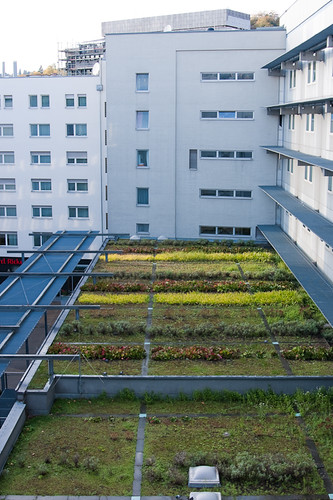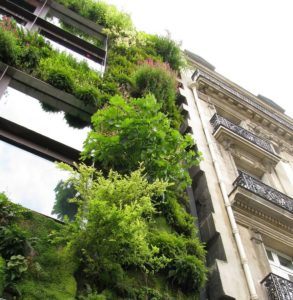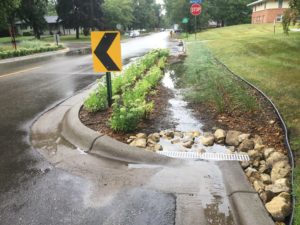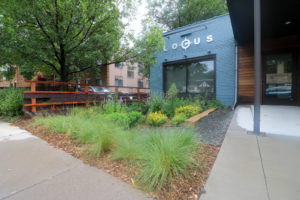Part 4 Plants for Horticultural Applications
32 Plants for Green Infrastructure Projects
Learning Objectives
- Describe plants suitable for green infrastructure projects.
The basic infrastructure that supplies a plant with water and food is made up of roots, stems, and leaves. By comparison, an infrastructure that supplies a community with drinking water is made up of a network of parts that include wells, reservoirs, water mains and smaller pipes. Other familiar examples of infrastructure found in communities are transportation, communications, and electrical networks. These constructed networks are often called grey infrastructure. In nature, networks of rivers, streams, lakes, and oceans make up a natural infrastructure that supports the function of ecosystems and the plants and animals that live there. Where human activities lead to the loss of ecosystems and biodiversity, green infrastructure can be planned and managed to conserve ecosystem services and reduce negative environmental impacts. Green infrastructure is made up of vegetation, soils, and bioengineered technologies that provide communities with a wide range of environmental, social, and economic benefits. When connected in a larger framework of natural and urban forests, habitats, streams and rivers, constructed wetlands and floodplains, as well as parks, residential yards, edible landscapes, community gardens, green roofs, green walls, bioswales, and rain gardens, a green infrastructure network is created.
Traditional stormwater infrastructure that collects, drains and discharges water from sites as quickly as possible can increase the potential for flash flooding, pollution, and scouring damage downstream. Sealed surfaces like rooftops, parking lots, and roads accelerate surface water runoff and prevent infiltration into soil for cleansing, groundwater recharge, and plant use. In contrast, green infrastructure for stormwater management mimics natural landscapes that intercept, retain, absorb, filter, and slowly release stormwater by evapotranspiration and controlled runoff. Combinations of green infrastructure components such as green roofs, green walls, bioswales, rain gardens, and permeable paving reduce the quantity and improve the quality of stormwater before its release from a site. Read more about the potential benefits of green infrastructure available at this link to Introduction to Green Infrastructure[PDF][New Tab].[1]
Green infrastructure is designed to optimize the beneficial services provided by plants. Plants and their processes of photosynthesis, water uptake, and respiration contribute to:
- oxygen production and carbon sequestration,
- pollution removal from air, soil, and water,
- flood control, and groundwater and stormwater management,
- surface shading and cooling of air temperature by evapotranspiration, and
- wildlife and pollinator habitat, and green space for human well being.
Plants for green infrastructure projects are often locally available native species, but not always. Both native and non-native plants are used for the ecosystems services a species or plant community provides. Plants suitable for the growing conditions, function, appearance, and maintenance levels associated with green roofs, green walls, bioswales and rain gardens will be selected within the constraints of a particular project.
Plants for green roofs
Green roofs that are partly or completely covered with vegetation and growing media provide many ecosystem services in urban settings. Services include reducing the volume of rainfall runoff through plant uptake, providing wildlife habitat and green space, and reducing the urban heat island effect through shading and plant evapotranspiration. In addition, the insulating properties of vegetation and growing media dampen noise levels, reduce the heating and cooling costs in buildings, and extend the life of roofing materials. Read more about the benefits of green roofs at this link to Green Roofs for Healthy Cities, About Green Roofs [New Tab].[2]
Green roofs are categorized as either intensive or extensive depending on the depth of growing media. Intensive green roof systems with growing media depths greater than 150 mm (6”) can support many plant types including ground covers, herbaceous species, shrubs, trees, and climbers. The high structural loading capacity of intensive green roofs also allows for access to amenities like paths, patios, and water features. Like a traditional garden on a roof, intensive plantings have high requirements for maintenance and inputs. In contrast, extensive green roofs with light weight growing media less than 150 mm (6″) in depth support plants with shallow roots and low requirements for maintenance and inputs. Extensive green roofs provide habitat for wildlife but their lower structural loading capacity may restrict human access to maintenance visits. Figure 9.1 shows an example of an extensive green roof that provides visual access to green space in an urban setting.

Almost any plant type can be grown on a green roof however, the shallow depth and low organic content of extensive green roof growing media will be the limiting factor for plant selection. In general, suitable species are determined by examining the microclimate of the green roof and comparing it to a species’ native habitat. Extensive green roof features that influence plant selection will include water availability, wind speeds, soil depths and temperatures, as well as solar exposure and climate. Plant growth characteristics for extensive green roofs include fast establishment, long lived with dense coverage, pest and disease resistance, shallow rooting, self-regeneration from seed and vegetative parts, tolerance for extreme weather and very dry to saturated conditions, and low requirements for maintenance and inputs. Examples of native habitats that match the extreme conditions found on extensive green roofs include:
- dry grasslands, cliffs and coasts,
- arid mountain ranges,
- steppe, heath, and alpine communities,
- sandy, talus, and cliff communities, and
- wastelands, gravel and sand pits, rocky outcrops, other hard surfaces.
Plants suitable for extensive green roofs may include succulents, bulbs and corms, annual or biennial self seeders, bunch and stoloniferous grass-like plants, and some wetland and perennial herbs. Succulents, in particular Sedum cvs. (stonecrop) have been extensively used because they are well adapted for growing in the extensive green roof microclimate. In addition to planting sedums, diversified communities may include adapted species such as Aster spp. (common aster), Campanula carpatica (Carpathian harebell, canterbury bells), Heuchera cvs. (coral bells, alumroot), Penstemon cvs. (beardtongue), Phlox subulata (creeping phlox), as well as sedges and grasses like Andropogon gerardii (big bluestem), and Panicum virgatum (switch grass).
Practice
Match the images of plants suitable for green roofs.
Plants for green walls
Green walls composed of vertical systems of vegetation, growing media, irrigation, and drainage are increasingly used in exterior and interior landscapes for their aesthetic and environmental benefits. The shading, water management, screening, buffering, and insulating properties of green walls can reduce air temperature, noise levels, and the energy costs for cooling buildings. The three major categories of green walls are green facades, living walls, and retaining living walls. Green facades of cable systems, trellises, arbors, and fences offset from a building face support the growth of vines and lianas or cascading plants that are rooted in ground level or above ground planters. Living wall systems of vegetated modules, panels, or bags containing growing media that are freestanding or attached to structural walls or frames support shallow fibrous rooted and creeping herbaceous and woody plants. Retaining living wall systems that are designed to stabilize slopes incorporate vegetation within interlocking geotextile fabric bags, mats, precast concrete units, or in woven wattles of Salix discolor (native pussy willow, pussy willow). Figure 9.2 shows an example of a living green wall on a building. Read more about the properties and benefits of green walls at this link to Green Roofs for Healthy Cities, About Green Walls [New Tab].[3]

Similar to green roofs, green walls have unique growing conditions that will influence plant selection. Factors for consideration include an indoor or outdoor climate, specialized soil requirements and wall orientation, the green wall design and level of maintenance required. Where green walls are not connected to groundwater, irrigation and intensive maintenance are necessary to ensure appropriate appearance and function. In situations where wall height and desiccation by wind and lack of shade limit plant growth, species adapted to cliff-faces, extreme slopes and thin soil habitats offer suitable choices. Depending on the type of green wall, suitable plants may range from annuals to herbaceous and woody perennials. Some examples of suitable species are Heuchera cvs. (coral bells, alumroot), Penstemon cvs. (beard tongue), Cotoneaster apiculatus (cranberry cotoneaster), Fragaria x ananassa (garden strawberry), and Gaultheria procumbens (wintergreen), as well as succulents and tropical species. Depending on the need for seasonal shading on buildings, green facades may include evergreen or deciduous climbers such as Actinidia kolomikta (actinidia) and Campsis radicans (trumpet vine).
Practice
Recognize plants suitable for green walls. Move cursor over images for plant names.
Plants for bioswales and rain gardens
Green infrastructure uses the process of bioretention to manage stormwater quantity and quality. Bioretention structures such as bioswales and rain gardens are designed to capture, detain, convey, infiltrate, and evaporate water from a planting. Vegetated bioswales are broad shallow straight or meandering channels with porous soil and gently sloped sides and bottom that collect and convey stormwater from one location to another while maximizing soil infiltration and plant uptake. Bioswales are designed to manage short intense periods of rain and flooding followed by dry periods. They reduce the impact of stormwater events and capture the first flush of pollutants from paved and sealed surfaces for remediation by plants and soil microorganisms. Figure 9.3 shows an example of how a vegetated bioswale captures and conveys stormwater runoff from the sealed pavement as well as the turf area.

Rain gardens are shallow infiltration basins located in depressions and low lying areas that capture and temporarily retain water for infiltration and groundwater recharge. Porous soil filters pollutants and allows for uptake and transpiration by plants to reduce air and water temperatures. Figure 9.4 shows an example of a rain garden. Note that the roof downspout enters the rain garden, and when combined with porous pavement, the site becomes an absorbent landscape.

Learn more about the components and characteristics of green infrastructure for stormwater management available at this link to Capital Regional District, Green Stormwater Infrastructure [New Tab].[4]
In addition to specific growing conditions and appearance expectations, plants for green stormwater infrastructure projects must fulfill basic functional requirements that include:
- tolerance and resilience to flooding, sediment events, drought, and wilting,
- extensive and deep root structure for resistance to heavy water flows,
- dense foliage and spreading growth that prevents erosion and increases evapotranspiration,
- reliable, vigorous growth without becoming invasive, and
- an ability to tolerate and accumulate contaminants from water or saturated soil.
Native and ornamental species are usually planted according to their tolerance for the wetter bottom or drier side and upper edges of bioswales and rain gardens. Where space and soil volume permit, planting trees and large shrubs such as Alnus rubra (red alder), Frangula purshiana (cascara), and Salix discolor (native willow, pussy willow) will prevent erosion and transpire great amounts of water. Examples of shrubs for bioswales and raingardens include Clethra alnifolia (summersweet), Ribes sanguineum (flowering currant, winter currant), Rubus spectabilis (salmonberry), and Symphoricarpos albus (snowberry). Where space for trees and shrubs is limited, planting multiple layers of herbaceous vegetation will increase the foliage density and the benefits of transpiration. Some examples of adapted herbaceous species include Aconitum napellus (monkshood), Aster spp. (common aster), Carex oshimensis ‘Evergold’ (Evergold Japanese sedge), Lysimachia clethroides (gooseneck lysimachia), Panicum virgatum (switchgrass), and Pennisetum alopecuroides (fountain grass).
Practice
Recognize plants suitable for bioswales and rain gardens.
In order for green infrastructure to provide ecosystem services as designed, maintenance practices must ensure appropriate vegetation cover for proper function and aesthetic performance. Improper maintenance can defeat the purpose of green infrastructure and lead to costly replacement or restoration. Routine maintenance involves inspection and repair for erosion, appearance, and removal of sediment and potential invasive species. Regular soil testing, weeding, and trash removal will influence the long term efficiency and effectiveness of pollutant removal and stormwater management by vegetated bioretention structures.

